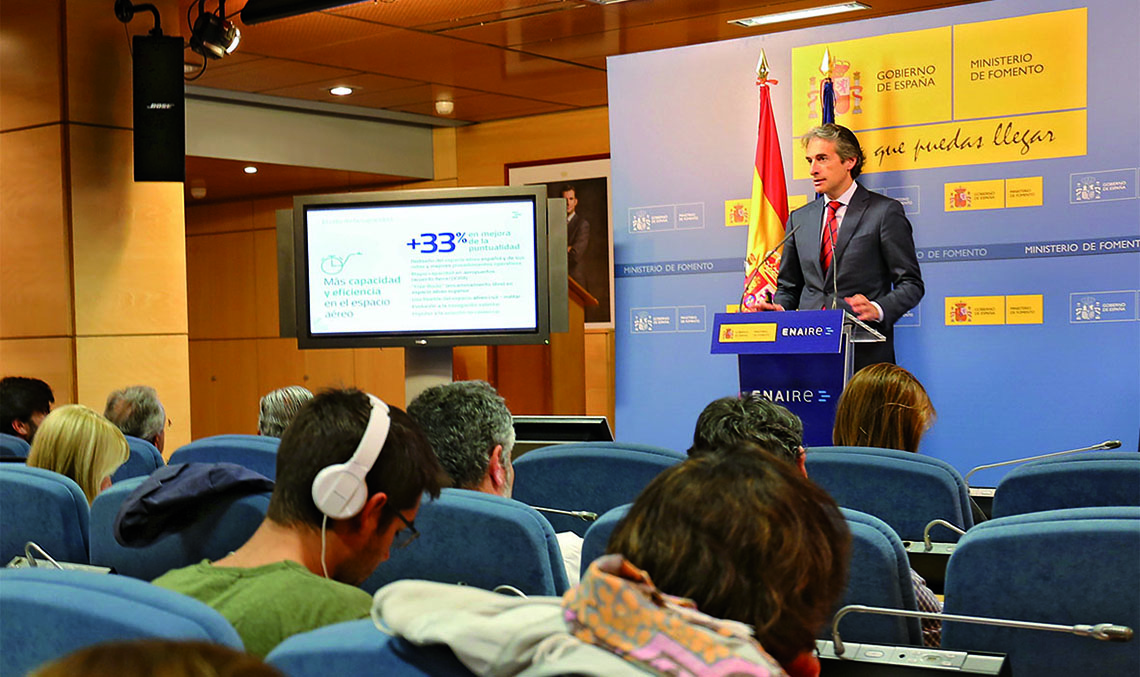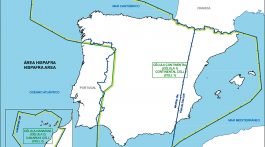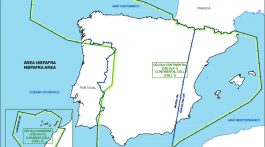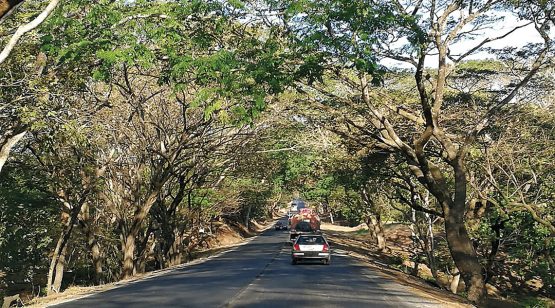On 10 May, the minister of Public Works, Íñigo de la Serna, submitted the Air Navigation Plan for 2017-2020, as the culmination of a long and participative process, opening the way to the progressive implementation of the ENAIRE’s new strategy. The strategic plan, known in ENAIRE as the Flight Plan 2020, is based on the predicted increase in traffic and the measures to be adopted to manage the expected demand for flights, with adequate capacity, efficiency and quality in regard to its customers and stakeholders.
Route charges will drop 11.5% between 2018 and 2020, reducing costs for airlines by 184 million Euros
ENAIRE’s ambition in its new strategy is “to lead the safe, efficient, quality and sustainable delivery of air navigation services in a competitive global environment, to be valued by customers and society, and depend on people as the main engine driving the company”.
To achieve this leadership, the main pillars are a commitment to society in terms of safety and the environment; customer-orientation, with special emphasis on the quality of services; teams committed to a proactive approach and innovation and, as a public business entity, transparency and good governance.
Capacity and efficiency
ENAIRE wants to respond adequately to the capacity requirements in an environment of increasing demand, while also improving airspace efficiency by helping users to optimise the distance flown.
The plan includes redesigning Spanish airspace to improve en-route operations and redesigning terminal areas, especially in Madrid, Barcelona and Palma, to improve operations in airports.
The Free Route concept (free route in the upper airspace), the flexible use of airspace thanks to civil-military coordination and the implementation of new procedures based on satellite technology will further contribute to the achievement of the capacity and efficiency objectives.
Where the investment is going
ENAIRE is Europe’s fourth largest supplier in terms of managed flights in its airspace, which is one of the most extensive in Europe, with 2.2 million square kilometres. The Single European Sky framework makes airspace an increasingly global and more competitive environment, and ENAIRE is focusing its investments, 300 million euros over the next four years, on upgrading and modernizing its air navigation system, incorporating research, development and innovation.
Investments (70.1 million euros in 2017, 73.3 million in 2018, 74.8 million in 2019 and 76.0 million euros in 2020) will be made, among many other aspects, in initiatives such as the following:
- Evolution of the Automated Air Traffic Control System (SACTA, as its acronym in Spanish) with advanced solutions and a new control position harmonized with the principal European suppliers (iTEC project).
- Modernization of voice communication systems between controllers and pilots, incorporating ground-to-air data links.
- Upgrading of navigation and surveillance systems: new precision procedures, state-of-the-art radar (Mode S) and satellite technologies (EGNOS, ADS-B).
- Deployment of a new high-performance data network for information exchange.
- Improvement of the maintenance model for infrastructure and air navigation systems.
More competitive charges
ENAIRE will reduce its route charges by 11.5% between 2018 and 2020 (3.0% in 2018, 4.0% in 2019 and 5.0% in 2020). After 2019, ENAIRE’s route charge will be in the lowest of the major European suppliers. The savings for airlines and, therefore, the improvement of the competitiveness of Spanish air transport, is expected to total 184 million euros.
Environmental benefits
The following environmental benefits will be achieved thanks to the improved efficiency of the 2017-2020 routes: savings of 5.5 million nautical miles, 60,000 tonnes of fuel and 190,000 tonnes of CO2. The fuel cost savings in the period will exceed 25 million euros.
Improving the efficiency of routes will reduce emissions by 190,000 tonnes
In Spain and in the world
ENAIRE provides air traffic services in 22 control towers in Spain’s airports, including the 5 airports with the largest traffic volume and in all airports that offer approach control. It has 307 radio aids, 54 surveillance systems, 130 communications centres, 100 REDAN nodes for voice and data, 94 control tower and approach positions, and 118 route positions.
Beyond Spain’s borders, ENAIRE is actively involved in international consortiums and satellite navigation (ESSP) and satellite surveillance (ADS-B) partnerships. It is also part of the Pan-European Digital Communications Service (NewPENS) until 2028, the European ATM Information Management Service (EAIMS) until 2030, and has opted for new opportunities in satellite data communications (IRIS) services.
How was the Plan conceived?
- In January, the professionals of ENAIRE participated in a survey on the necessary aspects to be included in the plan. The proposals that most interested ENAIRE employees were the organization and management of people, improvement of internal processes, communication, business development, management of the new company brand, and energy efficiency, among other aspects.
- In February, an updated version of the Flight Plan 2020 was presented to project managers, division heads, regional directors, trade union representatives and the Steering Committee.
- In March, the authorities, clients and stakeholders made their contributions: the General Secretariat of Transport, the General Directorate of Civil Aviation, Aesa, Aena, the State Trade Union Coordinator, Control Convention unions, Aprocta, the airlines and the Air Force.






